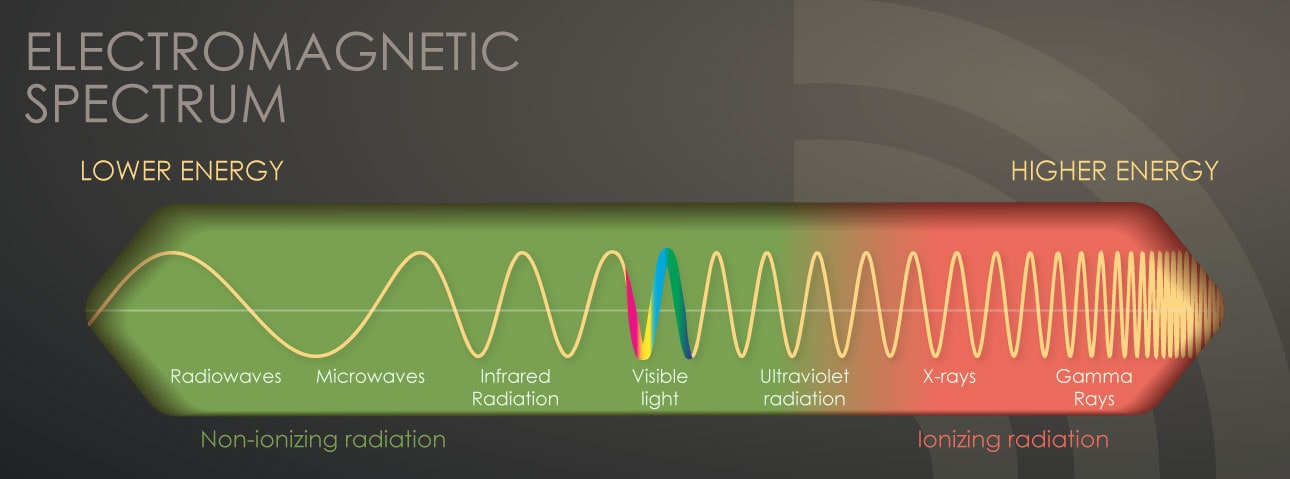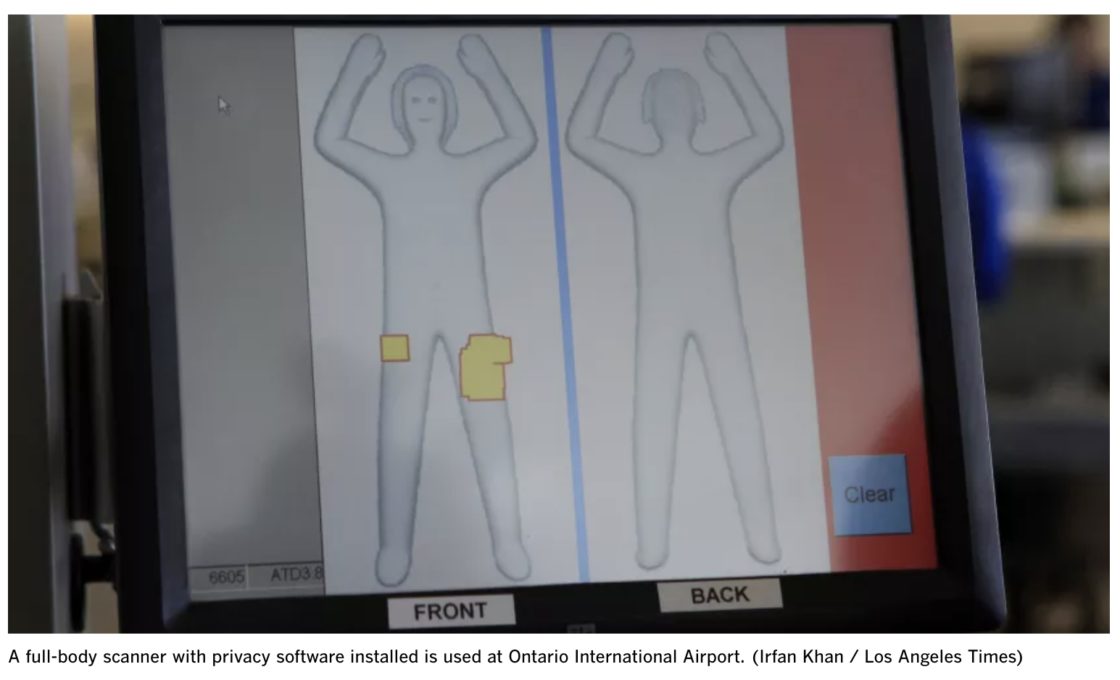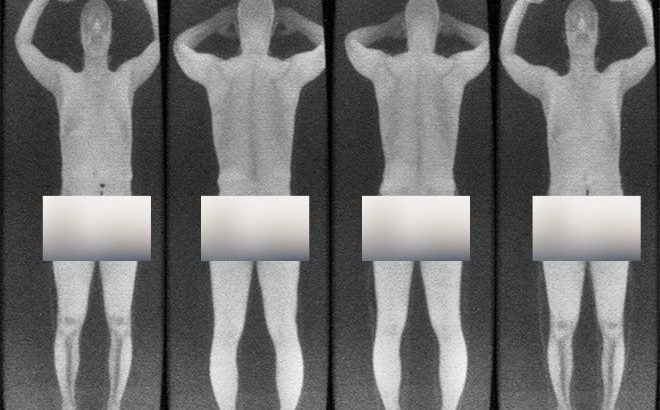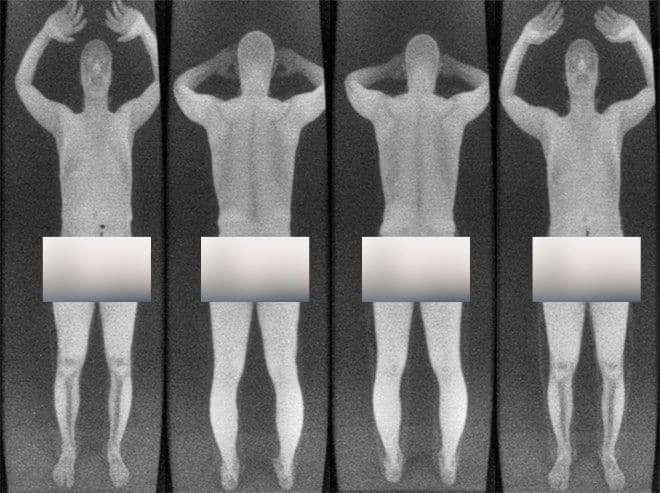If you have ever gone through a TSA body scanner there’s a good chance that you’ve wondered if your naked body is on display for someone in a mysterious back room.
It’s a valid worry but I think you’ll be happy to realize that you don’t have that much to worry about in today’s screening world.
Below, I will go into detail about TSA body scanners, the images that they display, and what it all means for your privacy, security, and health.
Table of Contents
TSA body scanners used today
There are multiple different types of full body scan machines used by various security checkpoints but the two most relevant to TSA are Backscatter X-rays and Millimeter Wave AIT scanners.
Backscatter machines are the original body scanners used by TSA and those machines utilized X-rays which contained ionizing radiation.
However, the Millimeter Wave AIT scanners utilize microwaves which contain non-ionizing electromagnetic radiation.
Sounds scary, right?
But it’s not too far from that utilized by cellular data transmitters.
Check out the diagram below that shows off the electromagnetic spectrum with mircowaves on the left and X-rays on the right.
TSA currently uses Millimeter Wave AIT scanners exclusively, which are designed to peer through clothing to look for both metal and non-metal objects.

Tip: Use the free app WalletFlo to help you travel the world for free by finding the best travel credit cards and promotions!
Brief history of TSA body scanners
TSA began deploying body scanners in 2010 and by the end of the year, the TSA had introduced 500 whole-body scanners at airports all across the US.
Why exactly were these “nudie scanners” added?
It had a lot to do with the 2009 underwear bomber attempt by Umar Farouk Abdulmutallab.
He was a Nigerian citizen who tried to blow up a Detroit-bound Northwest Airlines flight (on Christmas Day) by setting off explosives hidden in his underwear.
(It did not end well for him and he is currently serving four life sentences in a super max).
After this attempt, it became apparent to TSA that threats could be concealed beneath clothing and so they decided to introduce full body X-ray scanners.
These scans would presumably be more capable of detecting concealed metal, plastics, ceramics, chemical materials, and importantly, explosives.
The initial body scanners were very invasive and basically showed passengers near nude.
TSA tried to make up for this fact by allowing the agent who was doing the viewing to be seated about 50 to 100 feet away from the scanner.
That officer would then radio to another TSA officer who would actually do the follow up search if needed.
The thinking was that the officer who essentially saw you nude would never have any interaction with you.
TSA also stressed that the images were not saved or printed (although some images were saved and leaked in 2010).
You can see just how much detail they revealed in the images below. I edited one of the photos because they do show quite a bit of full frontal detail and my blog is (mostly) PG-13.
You can see the unedited image here (partial male nudity).
Here is another image of a man and a woman and you can really see how something like a firearm and a knife would stand out.
This type of scanner did have some major concerns about its ability to detect objects but more on that below.
/cdn.vox-cdn.com/imported_assets/1006463/bodyscanner.png)
The images above may freak you out but you will be happy to know that TSA no longer uses the Backscatter X-ray scanners that produced these detailed images.
That is because in 2012 Section 739 of the FAA Modernization and Reform Act required that all full-body scanners operated in airports by the TSA use “Automated Target Recognition” software.
This replaced the picture of a near-nude body with a funny looking, avatar-like image.
The vendor of these machines initially was going to implement a software update on the Backscatter machines but they failed to do so.
Thus, the TSA removed Backscatter X-ray machines by May 2013.
That is pretty much the summary although there are new scanners that use passive terahertz technology which are being tested.
These can view travelers from far away as much is 25 feet. For now, we will just focus on the Millimeter Wave AIT scanners.
How the body scan process works
If you are in the standard security checkpoint line you will first be asked to remove some clothing items including your shoes, belt, jackets, and also accessories like watches, phones, etc.
You want to make sure your pockets are completely empty because the scanners can pick up even the smallest items, including small drugs.
You will then be waived through so that you are standing inside of what feels like an oversized phone booth.
Your legs should be spread apart a bit and then you will lift both of your arms and slightly bend your elbows.
Basically, you’ll look like you’ve been frozen mid jumping jack.
The antennas will then scan you within a couple of seconds and depending on the type of message that the TSA agent sees you will then be directed to proceed through security or undergo more screening.
If you have TSA Pre-Check, you can usually avoid the full body scanners.
In addition to offering you access to an expedited security line, TSA Pre-Check also provides you with the following perks:
- Shoes can stay on
- Belt can stay on
- Light jackets can stay on
- Laptops allowed to stay in bag
- Liquids (3-1-1 Rule) can stay in bag
What does a TSA agent see from the body scanners?
Unlike back in the day where a TSA agent might see a near-nude image of your body, now a TSA agent will see one of two things after you are scanned.
If the scanner does not detect anything suspicious the screen will display the word “OK” with no image.
However, if the scanner detects something out of the ordinary there will be an avatar like outline of a human body (not your actual body) and wherever the suspicious item is detected, a yellow box will appear.
This is presumably where a TSA agent will want to search you to verify that the item is not a threat.

Declining the body image scanner
More than 99% of passengers choose to be screened by the full body scanners over alternative screening procedures.
If you are part of the one percent that would prefer not to go through the body image scanner you can avoid it but you will likely be subject to a type of physical screening such as a pat down.
This could be similar to a special SSSS search or a search you’d get if you didn’t have your ID.
There reportedly are some passengers who are not allowed to get by with just a pat down and have to go through the body image scanner but it seems like this is rare.
It could be random or in some cases you might be subject to secondary screening and need to consider a redress number.
Privacy issues
The big privacy issue that most people think about is the nakedness factor. Most people don’t like the thought of being gawked at by mysterious TSA workers behind a curtain.
But with the new software that TSA uses which doesn’t actually show bodily details that is not really a major concern for most.
I think a bigger issue is that the scanners could be tripped when they detect sensitive things like colostomy appliances, penile implants, and catheter tubes.
Related: TSA Medication Rules for Flying on Planes
Another issue with these scanners is that I have heard they can pick up scar tissue very well.
So for example if you had had a mastectomy or some other type of major surgery it’s possible that your scar tissue could trigger the scanner and force you to undergo an additional search in a sensitive region.
There’s also the issue of gender identity.
At least at one point the scanners were set to trip if they detected certain body parts that did not align with the gender they were programmed to be reviewing.
You could imagine how that could cause major issues for a lot of transgender people and inexperienced TSA agents who may not know how to properly handle the situation.
As more state IDs allow for non-binary people to select gender neutral or “X,” I would think these problems would decrease, but I’m not exactly sure how the gender selection process works with TSA’s software.
The good side of TSA scanning technology is that some believe that some of the scanners could be used as a potential to be a skin cancer diagnostic tool for finding early signs of malignant melanoma — a very serious type of skin cancer.
Safety & health concerns
Anytime you are dealing with waves being sent to or through your body there are always going to be questions about the safety of it all.
The Backscatter machines used X-rays which are ionizing radiation, and “more energetic than millimeter waves by more than five orders of magnitude.”
In short, the old machines were much more dangerous than the new ones.
But what about the radiation potential of the Millimeter Wave AIT scanners?
One major authority on this topic, Thomas S. Tenforde, president of the National Council on Radiation Protection and Measurements, said in 2010 that the scanners were probably within bounds [of standards for safe operation].
But he also emphasized that there should be an effort to verify that they are safe for frequent use.
A more recent study allegedly called the safety of these AIT scanners into question but other fact checkers have refuted/de-bunked these claims and clarified that there is no risk of DNA damage.
(The main study relied upon to call the safety of these scanners into question did not even focus on airport scanners.)
The reason why these millimeter waves are not viewed as very dangerous is that they are much larger than x-rays and do not involve ionizing radiation.
Ionizing radiation is the type of radiation that can alter the structure of molecules but this scanner does not emit that type.
Instead, it emits a type of microwave that is “thousands of times less than that of a cell phone transmission.”
Effectiveness
Many people question whether or not these full body scanners are actually effective.
Actually, the backscatter scanners were shown to be at least somewhat suspect at detecting weapons. They also were potentially subject to getting hacked with malware.
I also read that there were some tests done that showed the scanners did not detect a handgun hidden under an undercover agents undergarments.
However, this could be say more about the people monitoring the images than the machines.
I know from my personal experience that even the slightest object can trigger the scans. I once left a small painkiller tablet in my pocket and the agent was instantly notified and asked me to empty the pocket.
If anything the scanners might be overly sensitive.
One issue with the scanners is that there are some types of materials that make false positives more common such as folds in clothing and buttons.
Also, beads of sweat can trigger false positives on the scanners.
Just how common are false positives? Some countries, such as Germany, have reported a false-positive rate of 54%.
I don’t believe that the TSA body scanners can penetrate through your skin like other X-ray machines do.
So for example they would not detect things like tampons or menstrual cups inside your body from what I can tell.
However, please don’t try to sneak through TSA by sticking items in your bodily cavities.
If you are trying to smuggle drugs that way there are dogs that are trained to sniff drugs including those located in your bum or elsewhere.
Also, I’m pretty sure that if authorities suspect that you might be holding something inside your body they can order you to take a type of X-ray that will reveal items in your body cavities.
TSA Body Scan FAQ
TSA currently uses Millimeter Wave AIT scanners which use a form of electromagnetic radiation known as microwaves. These type of body scanners do not use X-rays.
Millimeter Wave AIT scanners emit a type of microwave which is non-ionizing radiation. According to the Centers for Disease Control and Prevention (CDC), “common exposures to non-ionizing radiation are not considered hazardous to you or your unborn baby.”
Millimeter wavelength radiation is used in the TSA full body scanners but it is non-ionizing and therefore incapable of causing cancers by radiolytic DNA bond cleavage. To date, there is not any evidence of harmful effects other than those caused by localised heating.
No, TSA cannot see you naked when they view the display screen from the full body scanner. Instead, they see a cartoon like representation of a human with highlighted sections if a suspicious item is detected.
After the underwear bomber’s attempt in 2009, it became more apparent that threats could be hidden beneath clothing, so TSA wanted a way wait to view potential explosives hidden under cloth.
Yes, most passengers can opt to avoid the full body scanner but they will likely be subject to a pat down. Also, those with TSA Pre-Check can avoid the body scanner.
No, in fact the scanning devices are not supposed to allow TSA to store any of the images. However, in the past some images (35,000) were being saved and some even got leaked.
Final word
Hopefully after reading this article you are a little bit relieved and you learned something about the evolution of the TSA full body scanner.
If you are at all bothered by the scanner I would highly recommend getting TSA Pre-Check so that you can avoid the scanner for the most part.
And just remember the privacy concerns are not nearly as bad as they once were and there is no evidence that you are subject to dangerous radiation.
Daniel Gillaspia is the Founder of UponArriving.com and the credit card app, WalletFlo. He is a former attorney turned travel expert covering destinations along with TSA, airline, and hotel policies. Since 2014, his content has been featured in publications such as National Geographic, Smithsonian Magazine, and CNBC. Read my bio.


